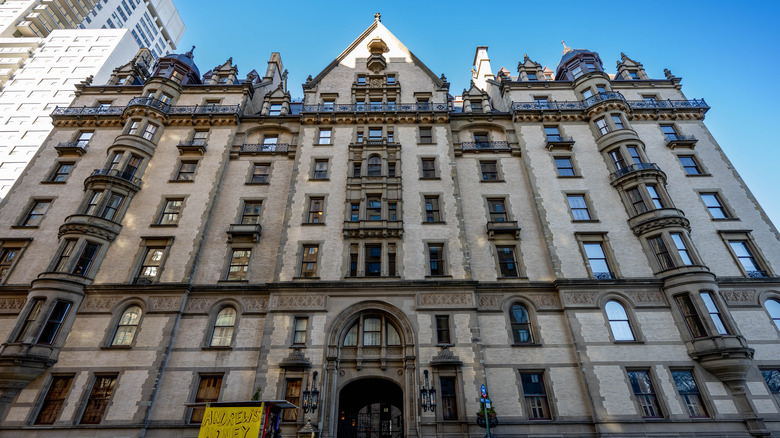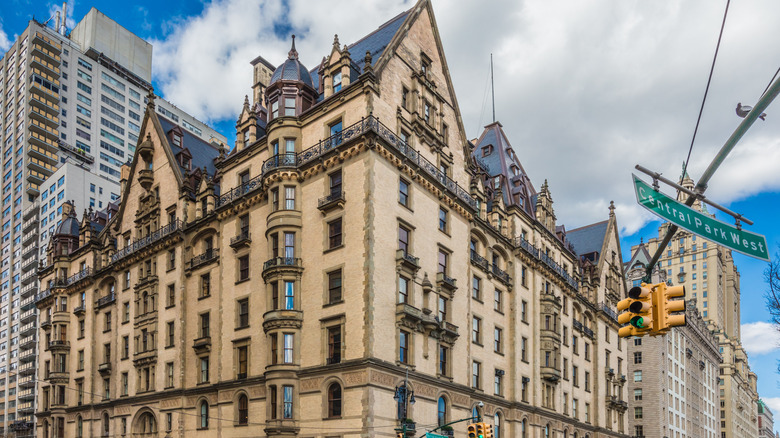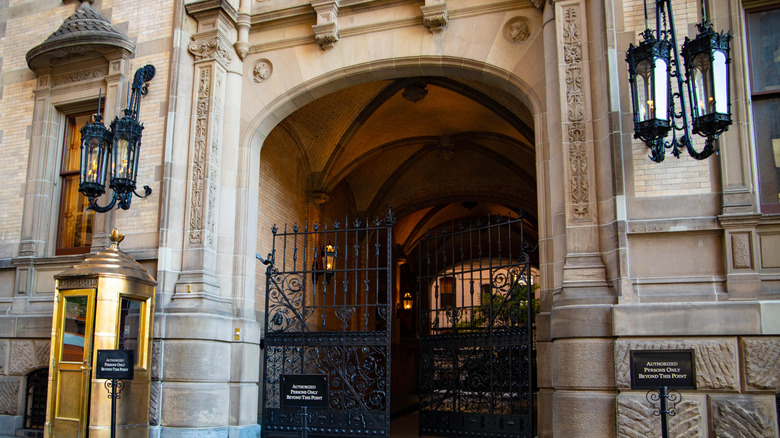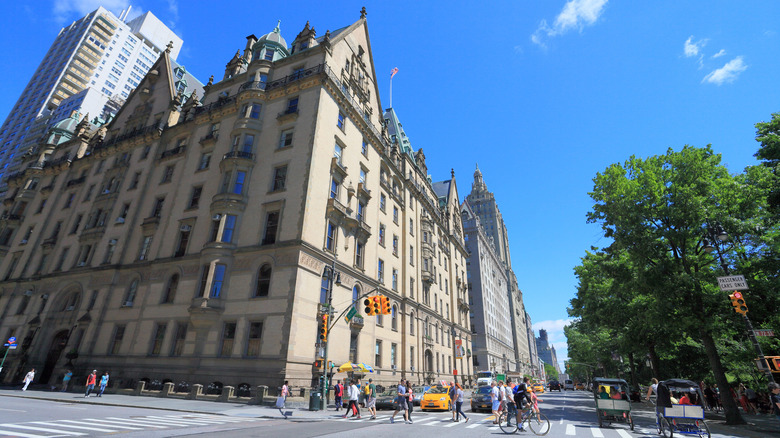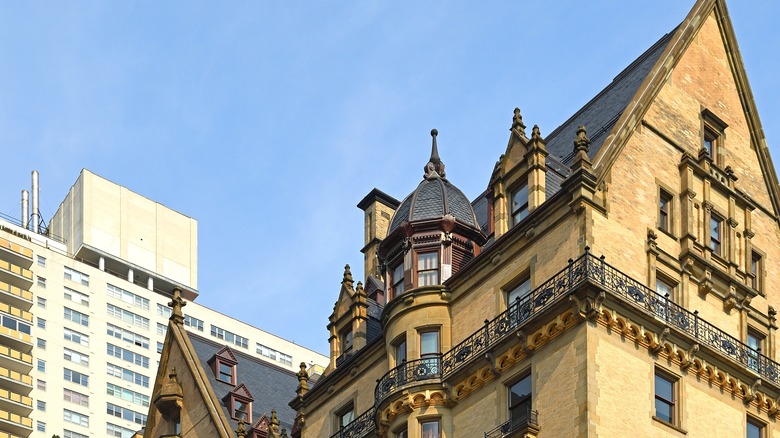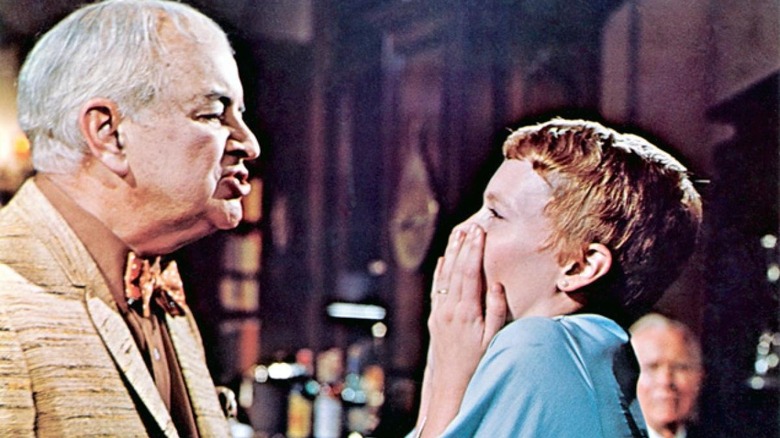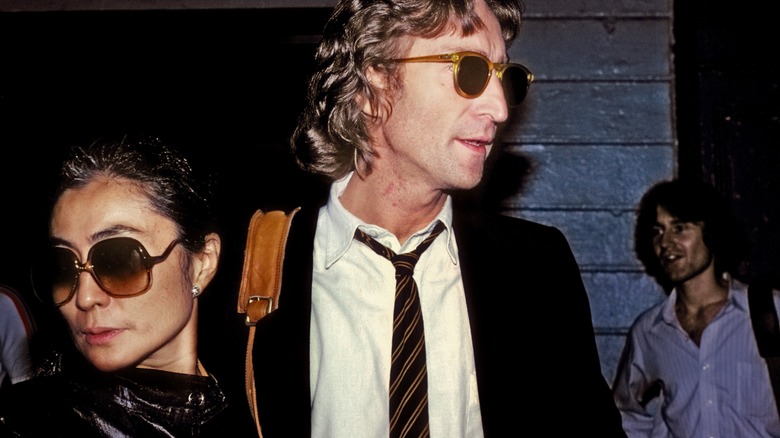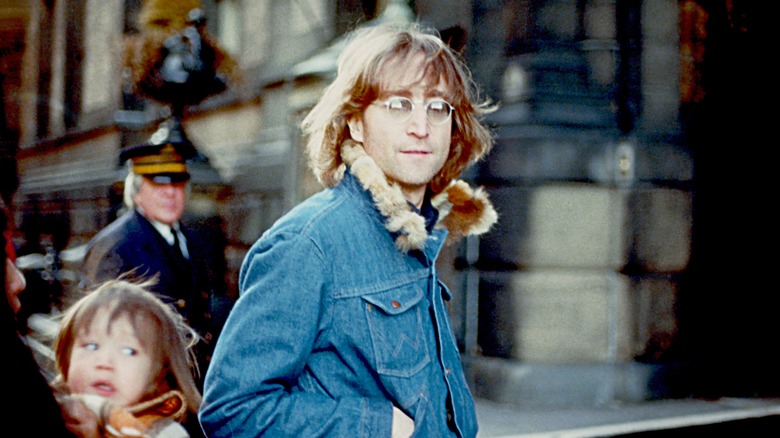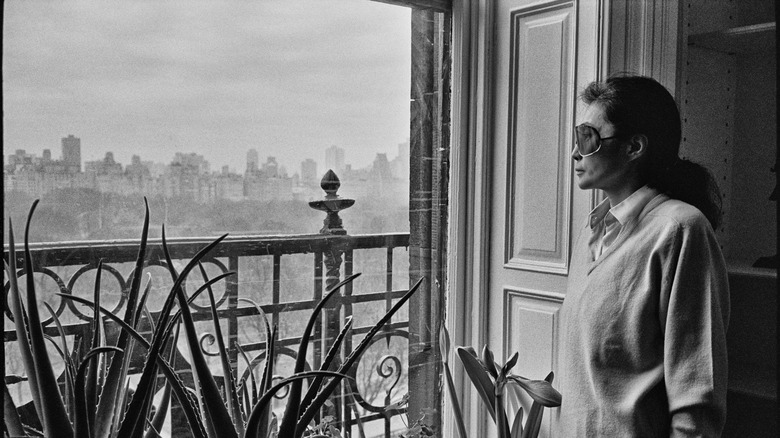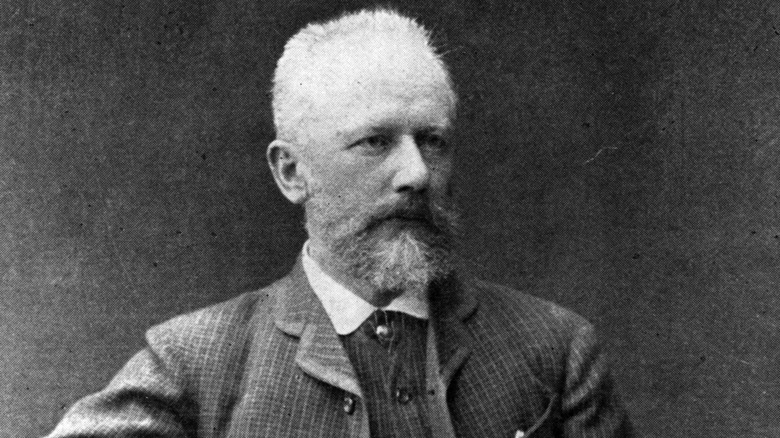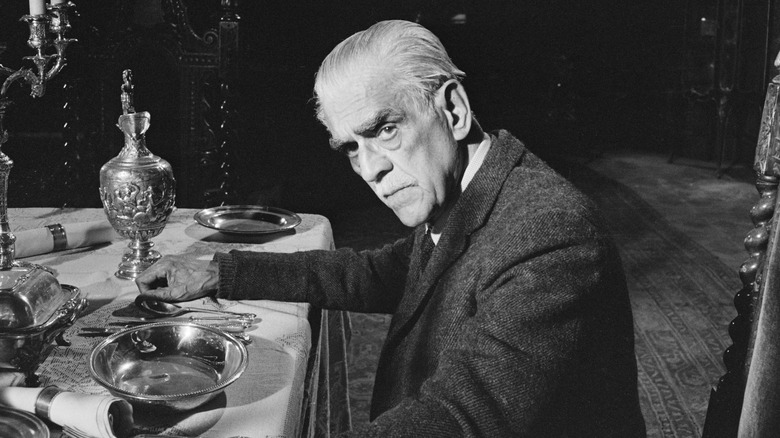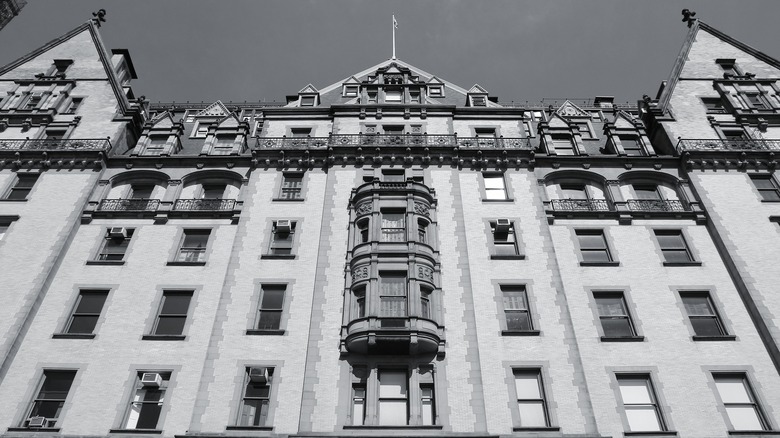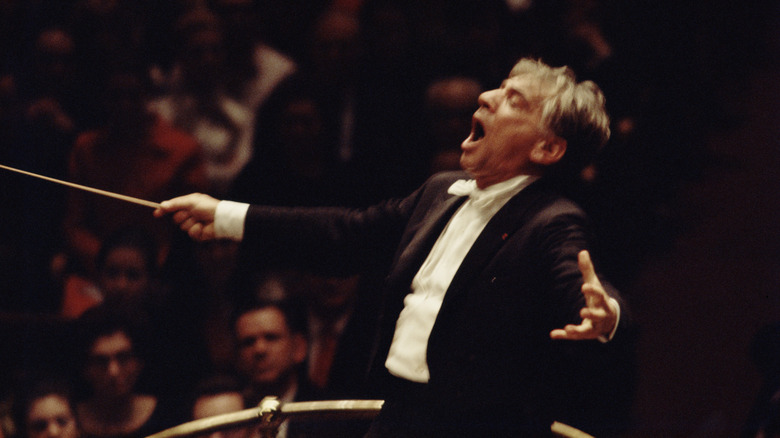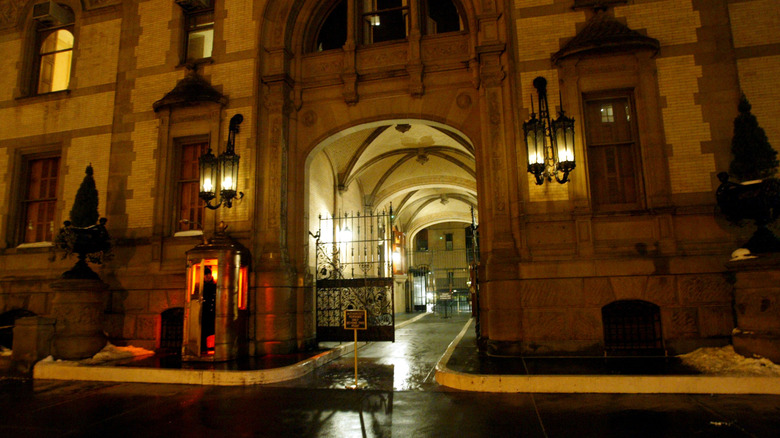The Untold Truth Of NYC's Dakota Building
If walls could talk, the Dakota building would have enough stories to pen a library's worth of novels. Since its construction in the 1800s, its imposing appearance and Victorian architecture have loomed over New York City like an all-seeing and all-knowing god. It has character and presence and is cloaked in an elusive air of mystery. It's a world-famous landmark that the likes of John Lennon, Yoko Ono, Boris Karloff, Leonard Bernstein, Lauren Bacall, Judy Garland, and others have called home, as per Fancy Pants Homes. For decades it's been an extremely popular address amongst the Manhattan elite, and it is a notoriously hard residence to obtain, even if your face is familiar to millions and you have enough wealth to buy a small island.
Sitting pretty in Upper West Manhattan, where it hangs opposite Central Park on the corner of 72nd Street and Central Park West, Big Apple's most well-known apartment block is perhaps most famous for being the place where John Lennon lived the last seven years of his life before he was gunned down when returning home one fatal December night. The late Beatle's murder may haunt the Dakota, but it does not overshadow or define it. There are stories in its stones and tales in its timbers that have been buried for decades and are long overdue an airing. Let's lift the floorboards, check behind the walls, and bury deep in search of the untold truth of the Dakota.
The visionary behind The Dakota was a lawyer named Edward Clark
Before they are made concrete, great buildings, like ideas, are as insubstantial as smoke on the water. It takes a visionary with great purpose and momentum to bring them to life. In the case of the Dakota, that individual was a lawyer named Edward Clark, who made his money as co-founder of the Singer Sewing Machine Company. The New Republic reports that although architect Henry Janeway Hardenbergh was responsible for the Dakota's design, businessman and real-estate investor Clark provided the required money, planning, and time to make New York's first co-op building a reality. In his book, "The Dakota: A History of the World's Best-Known Apartment Building," author Andrew Alpern describes Clark as an individual ahead of his time who thought outside of the box, much like Steve Jobs.
Clark was said to have had an intuitive understanding of the new urban bourgeoisie for whom the Dakota was tailor-made. Consisting of mainly marshland and wasteland, the Upper West side looked very different when the Dakota was first built. An 1889 copy of Frank Leslie's Illustrated Newspaper described it as a "great overshadowing mass of brick and stone." Just imagine what they'd make of modern Manhattan? According to Triplemint, Clark's Dakota apartment was designed to be the most ornate and elaborate. Sadly, Clark would never get to see his pet project completed. He died before the building was declared open.
The Dakota architect also designed the Waldorf Astoria and Plaza Hotel
Designing an instantly recognizable New York landmark such as the Dakota is enough for any architect to lunch out on for the rest of their days. Yet Henry J. Hardenbergh wasn't one for resting on his laurels — he would also go on to be the driving force behind the Waldorf Astoria and Plaza Hotel, as per Untapped New York. However, it was Hardenbergh's unusual design for the Dakota that he's best remembered for. By merging influences from a number of key architectural designs such as the Gothic Revival and German Renaissance, Hardenbergh's final design is hard to pigeonhole. One thing's for certain, it is certainly dynamic and makes an impression on everyone who lays eyes on it for the first time.
The New York Times reports that Hardenbergh was New Jersey-born and bred. The son of an importer, he served his apprenticeship under German architect Detlef Lienau, and his hand helped build New York as we now know it. His work had a reputation as being solid and dependable, and he prided himself on designing buildings that would stand the test of time. The Dakota's 10 stories, yellow brick, bay windows, bronze staircases, marble walls, and luxury departments have, much like a fine wine, certainly aged well.
Apartment living in New York was considered undesirable before The Dakota
In most circles, if you tell people you live in a Dakota apartment, it will raise a few eyebrows, possibly even heckles. It's the nature of the beast. Yet prior to the Dakota, apartment living in New York wasn't considered desirable for those with wealth, taste, and judgemental neighbors. According to Untapped New York, before the Dakota appeared on the block, apartment living was viewed by the affluent and well-to-do as a bit beyond the pale. From the vantage point of their plush townhouses, rich New Yorkers viewed apartments as being cramped, impoverished, and something that would see them banished from polite society.
Edward Clark's revolutionary vision sought to change that mode of thinking. By ensuring that the Dakota came fully equipped with room service, a restaurant, a laundry, a gym, and a housekeeping staff consisting of maids, janitors, chimney sweeps, and a man to operate that complex and futuristic piece of tech we know as the elevator, New York's great and good felt safe enough to release their servants back into the economy and move into the Dakota. So great was the number of housekeeping staff, that initially, the top two floors of the Dakota were designed as quarters for them to live.
There is some confusion as to how the Dakota got its name
Names have meaning, and they also have power. This rings no less true for buildings. The White House, Graceland, and the Dakota are all simple names, yet they seem to cast a spell and evoke all manner of associations when heard or read. This brings us nicely to the nagging question of how the Dakota got its name. According to Architectural Digest, there is an unsubstantiated claim that the location of the building was so remote and removed from the hustle and bustle of downtown New York that it was the equivalent to the Dakotas of the Wild West. "The Dakota reflected [Clark's] vision to establish the district as an upscale suburb," Tom Miller, writer of the New York history blog Daytonian in Manhattan, told the publication. The unmistakable Dakota Native American positioned on the building roof also lends credence to this theory.
However, in his book, "The Dakota: A History of the World's Best-Known Apartment Building," author Andrew Alpern this theory lacks credibility because it has never been backed up with any legitimate sources. Additionally, there is no mention of how the Dakota got its name in articles from the period it was built. The first mention of the origin myth was in a 1933 copy of The New York Herald. Building manager George P. Douglass is quoted as saying, "Probably it was called Dakota because it was so far west and so far north." "Probably" being the definitive word.
The Dakota was used for the filming of 'Rosemary's Baby'
If you could use one word to describe the appearance of The Dakota, nine times out of 10, that word would be "gothic." Its gargoyles, spires, and turrets all conspire to make it look like the sort of building where spooky things happen. It's no wonder director Roman Polanski thought it would make the perfect choice for the apartment building in his 1967 satanic thriller "Rosemary's Baby," as per ClassicNewYorkHistory. Staying true to the novel by Ira Levin that the film is based on, the apartment in the movie is named the Bramford, but when we see that dark and menacing symmetry highlighted against the New York skyline, it is unmistakably the Dakota.
In "Rosemary's Baby," the Dakota perfectly ties into the themes of material status and domestic bliss disguising some deeply unsettling truths. It's almost as if the building relished its cameo in one of the all-time horror movie classics. The scenes shot within the Dakota's interior feel unforgettably menacing, and apart from "House of Strangers" (1949), it was the only time a film crew has been allowed inside. (However, the exterior of the building was used for Tom Cruise's "Vanilla Sky.")
John and Yoko owned five apartments at the Dakota
These days, a buyer has to jump through many hoops and tick many boxes to lay their hands on an apartment in the Dakota. It comes gift-wrapped with a certain prestige and automatic status. So imagine getting to own five apartments in one of New York's most exclusive buildings. According to The New York Times, John Lennon and Yoko Ono did just that. The man who penned such otherworldly classics as "Strawberry Fields Forever" was also something of a real estate investor. Living on the seventh floor since 1973, Lennon treasured the privacy and security that the Dakota afforded him. He also loved the vibrancy of New York City and the anonymity he found there, so he went on a property spending spree.
In addition to owning two apartments on the seventh floor, the rock power couple purchased three other apartments in the Dakota for entertaining guests, work, and storage. It was allegedly something of a bug-bear with a handful of fellow tenants. Former Dakota acceptance board member Mr. Paul Goldberger explained, "There was a little bit of resentment built up against Yoko, more because she kept trying to buy more apartments. I think people didn't dare get mad at John Lennon, so she bore the brunt of any resentment." Fellow Dakota tennent and singer Roberta Flack defended John and Yoko's decisions to snap up the apartments and said she wished she had done the same in hindsight.
John Lennon believed the Dakota was haunted
Like most gothic-looking buildings that have housed hundreds of people and were built in a century far removed from this one, the Dakota has always been branded as something of a haunted house. ABC News reports that the Dakota is one of NYC's most haunted homes. Construction workers in the 1960s alleged they witnessed the strange sight of a man with the face of a young child roaming the grounds, and this was before botox was even a thing! Numerous residents in modern times have claimed to have seen a young girl dressed in the style of the 19th century waving and smiling at them from the lower windows. According to NY Ghosts, Dakota residents have also complained about peculiar noises such as tiny footsteps running through their apartments.
Even the famously cynical and sarcastic John Lennon would confide to friends he had repeatedly bumped into what he described as the "crying lady ghost," who was said to hang about benevolently in the corridors of the Dakota. In a bizarre twist of fate, the ghost of Lennon is also rumored to haunt the Dakota since his murder in 1980. Witnesses claim shortly after his death, they saw him in his trademark white flare suit leaning nonchalantly against the entrance where he was gunned down. Even his widow, Yoko Ono, has confessed she has seen the ghost of her former husband playing the piano in the place he once called home.
The Dakota is haunted by the murder of John Lennon
Although allegations of the ghost of John Lennon haunting the Dakota remain unproven, his life and legacy hang heavy over the iconic NYC building. Depending on which biography you read, John Lennon's tenure at the Dakota was one of reclusive paranoia and drug-addled apathy or that of a happy house-husband who spent his days baking bread and playing with his son. Either way, his time at the Dakota has been the subject of much speculation and the source of much fascination. Sadly, it always ends in the same way, with a gunman ending his life short. The sad circumstances of that tragic night have left an indelible stain on the Dakota that time or distance cannot wash away.
CNN reports that at the time of his murder, most fans of John Lennon and The Beatles knew he lived in NYC but probably wouldn't have heard of the Dakota. Yet on the night of December 8, 1980, live news reports featuring the Dakota in the background were broadcast across the globe. For a tearful audience, it was their first glimpse of the place Lennon called home.
Tchaikovsky was rumored to be incredibly impressed by his visit to the Dakota
John Lennon was not the first world-famous musician to grace the Dakota. In Stephen Birmingham's book, "Life at the Dakota: New York's Most Unusual Address," the author recalls the time in 1891 when Pyotr Ilyich Tchaikovsky visited the apartment of his music publisher, Gustav Schirmer. As part of his only North American tour, Tchaikovsky was to perform at Carnegie Hall. While in town, he was invited for an evening at the Dakota.
The tale goes that after a lavish dinner, Schirmer invited the composer onto the roof of the building to admire the spectacular view of Central Park. Because Tchaikovsky didn't speak English, something must have got a little lost in translation. The Russian later confessed in his diary, "No wonder we are so poor. The American publisher Mr. Schirmer is rich beyond dreams. He lives in a palace bigger than the Czars! In front of it is his own private park!" Either Tchaikovsky got his wires crossed, or Schirmer was guilty of little more than just a humble brag!
Boris Karloff was the first actor to move into the Dakota
When you're the man who is famous for playing Frankenstein, you're going to need a pad that lives up to your reputation as a horrorshow icon. The moody, sullen, and in a certain light, somewhat sinister vibe of the Dakota appeared tailormade for an actor like Boris Karloff. According to JAQUO, in 1930, Karloff was the first actor to move into the Dakota, and wasn't universally welcomed by the rest of the tenants. The wealthy residents believed having a common thespian hanging around like a bad smell would lower the prestige and prices of the property.
However, time has proven their fears were ungrounded. Karloff may have been the first actor to pass through the doors of the Dakota, but he certainly wasn't the last. In his wake came Hollywood icons such as Lauren Bacall, Jack Palance, Lillian Gish, Robert Ryan, and perhaps most famous of all, Judy Garland. Apparently, the "Wizard of Oz" star only lived there for a short and unspecified period, so it wasn't exactly her "Somewhere Over the Rainbow" dream home, but the Yellow Brick Road once led her to the Dakota's door. In 2017, Mansion Global reported that her old nine-room apartment boasting 13-foot ceilings was on the market for a cool $10 million.
Is there such a thing as the Dakota curse?
Due to its high turnover of residents and the fact that it has been standing for well over a century, the Dakota has been home to all manner of individuals who have endured much misfortune and tragedy. So is there such a thing as the Dakota curse or is simply a case of historic happenstance? The speculation surrounding the fate of people who have a connection to the Dakota persists. And just as there is no smoke without fire, the whispered rumors and half-baked conspiracies have an element of truth.
Vanity Fair reports that after the filming of "Rosemary's Baby" at the Dakota, a number of people involved with the movie suffered extremely bad luck. Producer William Castle was hospitalized with a bad bout of kidney stones and suffered from severe hallucinations. Krzysztof Komeda, who scored the soundtrack, lapsed into a coma. And Sharon Tate, the wife of director Roman Polanski, was subsequently murdered by the Manson family.
John Lennon was assassinated when living at the Dakota, and fellow resident Judy Garland also died young from an overdose. As did actress Judy Holliday, who lived in apartment 77 and passed away from cancer, aged 43. The man responsible for the Dakota, Edward Clark, also died before his dream project came to fruition. However, all apartment blocks that have housed generations of people will have similar tales and tragedies to tell. It's all part of life's rich tapestry. The Dakota is probably not cursed; it's just a place that many people — particularly famous ones — have called home.
Leonard Bernstein's Dakota apartment sold for $21 million
There's no point beating around the bush. The Dakota has always been and always will be an extremely expensive place to live. But how expensive is extremely expensive? Well, if you have to ask, chances are you'll never live in an apartment overlooking Central Park West. Just ask Leonard Bernstein. The famous composer's second-floor apartment broke records when it was purchased for $21 million in 1997. It was on the market for $25.5 million, but there was a little wiggle room on the asking price. The real estate agents took a healthy chunk of commission at $1 million and everyone went home happy.
According to CNBC, Bernstein lived in apartment 23, which enjoyed views of the park and housed a library, four bedrooms, four bathrooms, a dining room, and a living room. It wasn't a huge pad, but then again you're paying for the address as opposed to the space. Apart from John Lennon and Bernstein, other famous musicians such as Paul Simon and Bono have also had residences at the Dakota.
Dakota's co-op board has refused entry to a host of famous faces
As a celebrity in an age that fetishizes fame, there are not many places that will deny you entry. Yet the Dakota co-op board does things a little differently. While the inhabitants might be wealthy and privileged, they have no time for the cult of celebrity. Anyone wishing to live in this highly select corner of Manhattan must first subject themselves to a thorough application process that has scant regard for the fame of the applicant. CNBC reports that the Dakota Board requires a wealth of financial statements, tax records dating back years, and a detailed background check before they even consider letting any would-be-resident get a foot in the door.
After the hopefuls have paid thousands of dollars to oil the cogs of the process, acceptance is still not guaranteed. Big names such as Madonna, Billy Joel, Cher, Antonio Banderas, Melanie Griffith, and Carly Simon have failed the Dakota's stringent acceptance policy. Yet, according to the legendary documentary filmmaker Albert Maysles, who sold his Dakota apartment in 2005 after being a resident for over three decades, the co-op board has lost touch with what once made the Dakota great. He told The New York Times, "What's so shocking is that the building is losing its touch with interesting people. More and more, they're moving away from creative people and going toward people who just have the money."
